『计算机视觉』Mask-RCNN_训练网络其三:训练Model
Github地址:Mask_RCNN
『计算机视觉』Mask-RCNN_论文学习
『计算机视觉』Mask-RCNN_项目文档翻译
『计算机视觉』Mask-RCNN_推断网络其一:总览
『计算机视觉』Mask-RCNN_推断网络其二:基于ReNet101的FPN共享网络
『计算机视觉』Mask-RCNN_推断网络其三:RPN锚框处理和Proposal生成
『计算机视觉』Mask-RCNN_推断网络其四:FPN和ROIAlign的耦合
『计算机视觉』Mask-RCNN_推断网络其五:目标检测结果精炼
『计算机视觉』Mask-RCNN_推断网络其六:Mask生成
『计算机视觉』Mask-RCNN_推断网络终篇:使用detect方法进行推断
『计算机视觉』Mask-RCNN_锚框生成
『计算机视觉』Mask-RCNN_训练网络其一:数据集与Dataset类
『计算机视觉』Mask-RCNN_训练网络其二:train网络结构&损失函数
『计算机视觉』Mask-RCNN_训练网络其三:训练Model
一、模型初始化
1、创建模型并载入预训练参数
准备了数据集后,我们开始构建model,training网络结构上一节已经介绍完了,现在我们看一看训练时如何调用training结构的网络。
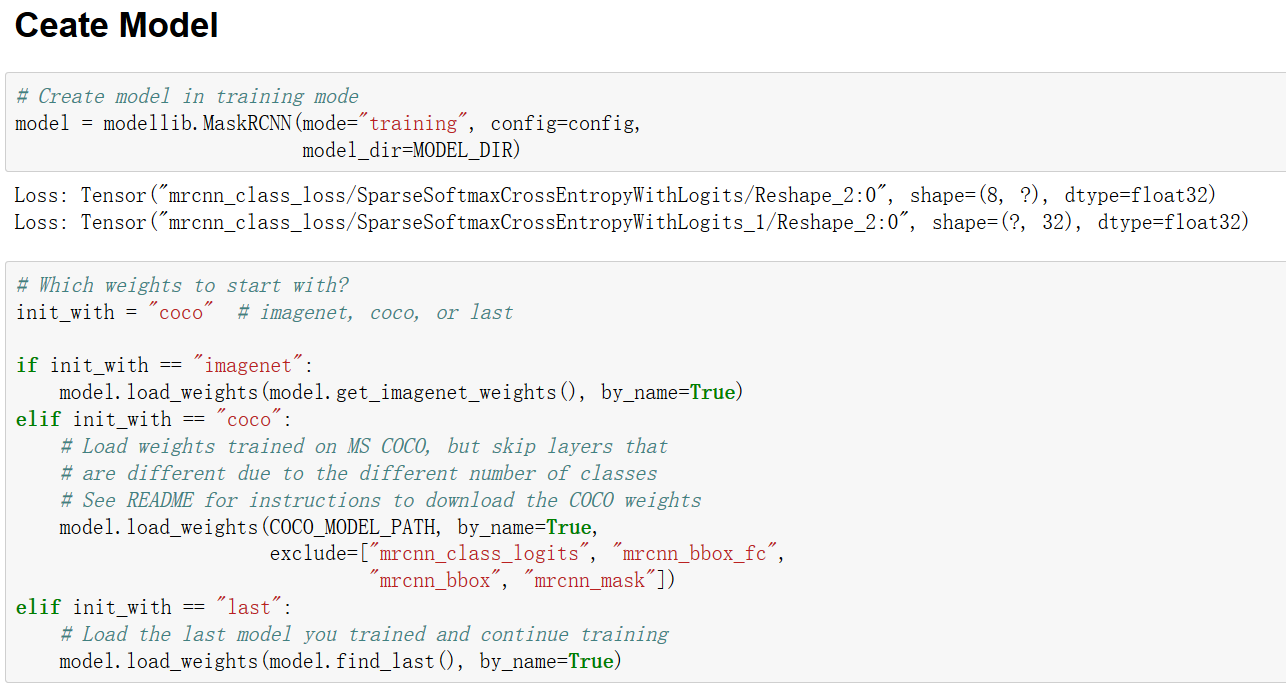
如上所示,我们首先建立图结构(详见上节『计算机视觉』Mask-RCNN_训练网络其二:train网络结构),然后选择初始化参数方案
例子(train_shape.ipynb)中使用的是COCO预训练模型,如果想要"Finds the last checkpoint file of the last trained model in the
model directory",那么选择"last"选项。
载入参数方法如下,注意几个之前接触不多的操作,
- 载入h5文件使用模块为h5py
- keras model有属性.layers以list形式返回全部的层对象
keras.engine下的saving模块load_weights_from_hdf5_group_by_name按照名字对应,而load_weights_from_hdf5_group按照记录顺序对应
def load_weights(self, filepath, by_name=False, exclude=None):
"""Modified version of the corresponding Keras function with
the addition of multi-GPU support and the ability to exclude
some layers from loading.
exclude: list of layer names to exclude
"""
import h5py
# Conditional import to support versions of Keras before 2.2
# TODO: remove in about 6 months (end of 2018)
try:
from keras.engine import saving
except ImportError:
# Keras before 2.2 used the 'topology' namespace.
from keras.engine import topology as saving if exclude:
by_name = True if h5py is None:
raise ImportError('`load_weights` requires h5py.')
f = h5py.File(filepath, mode='r')
if 'layer_names' not in f.attrs and 'model_weights' in f:
f = f['model_weights'] # In multi-GPU training, we wrap the model. Get layers
# of the inner model because they have the weights.
keras_model = self.keras_model
layers = keras_model.inner_model.layers if hasattr(keras_model, "inner_model")\
else keras_model.layers # Exclude some layers
if exclude:
layers = filter(lambda l: l.name not in exclude, layers) if by_name:
saving.load_weights_from_hdf5_group_by_name(f, layers)
else:
saving.load_weights_from_hdf5_group(f, layers)
if hasattr(f, 'close'):
f.close() # Update the log directory
self.set_log_dir(filepath)
2、从h5文件一窥load模式
keras model的层
对于layer对象我们有一下几点说明
layer.name:查询层对象的节点名称
layer.trainable:层对象是否可训练
对于TimeDistributed对象,其.layer方法返回对象才是我们要设定的层对象
载入模型并查看layers如下,
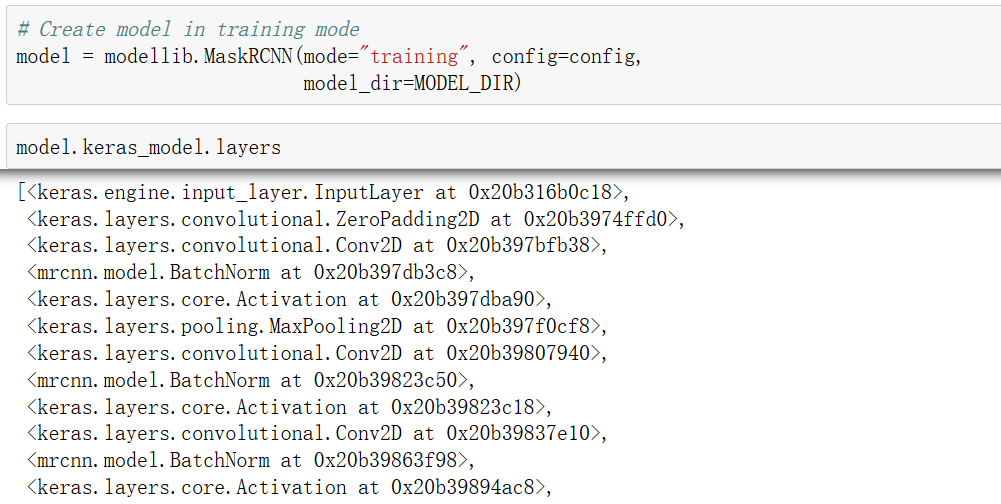
查看名称如下,名称即我们在build函数中为每个层设置的名称,和TensorFlow一样,参数载入依赖于此。
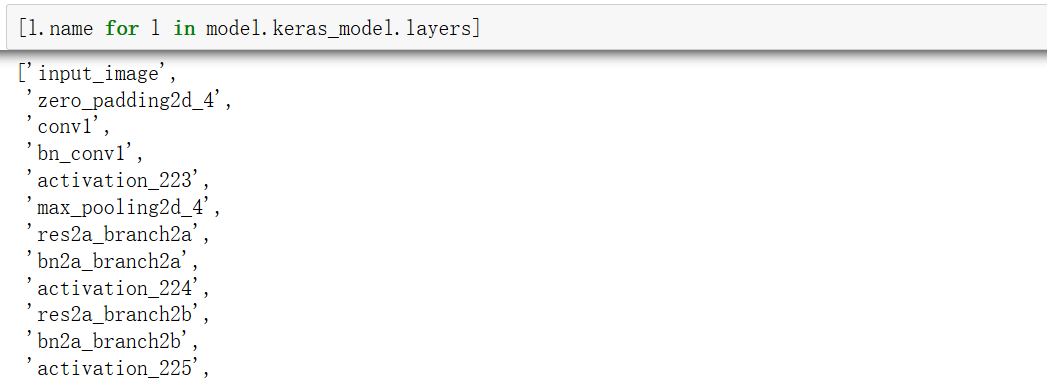
h5 文件记录
载入h5文件并查看,f.attrs记录了三个值,第一个为字符串list,后两个均为字符串,对于"layer_names"我们如下尝试,其记录了各个层的name字符串(h5记录的都是二进制形式,需要转码)
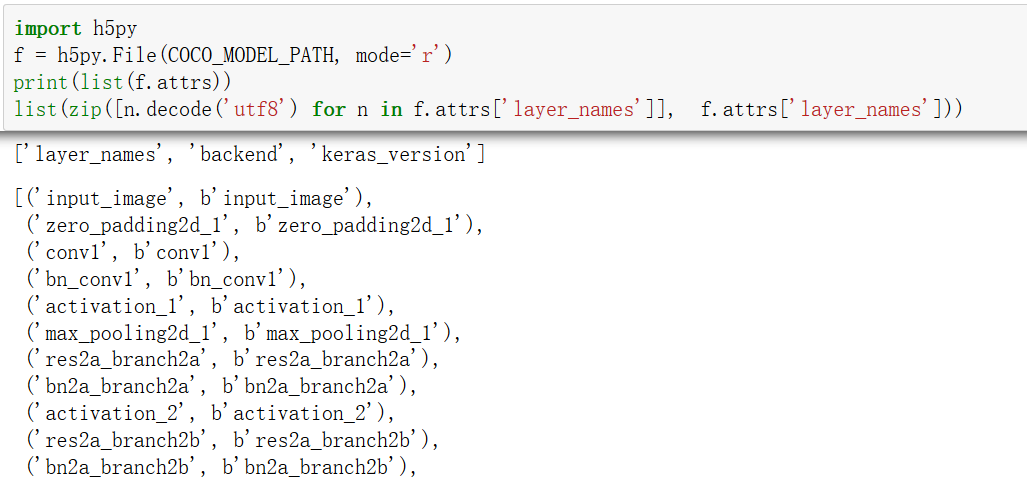
在keras.engine的saving方法中,可以看到后两个记录的解析,实际测试一个是keras的版本号,一个会返回b'tensorflow'
if 'keras_version' in f.attrs:
original_keras_version = f.attrs['keras_version'].decode('utf8')
else:
original_keras_version = '1'
if 'backend' in f.attrs:
original_backend = f.attrs['backend'].decode('utf8')
else:
original_backend = None
"layer_names"记录的字符串们可以视为h5文件索引,其索引对象为子h5对象,子h5对象有attrs:"weight_names",也是字符串list,可以索引子h5对象,其索引出的便是参数值,示意如下:
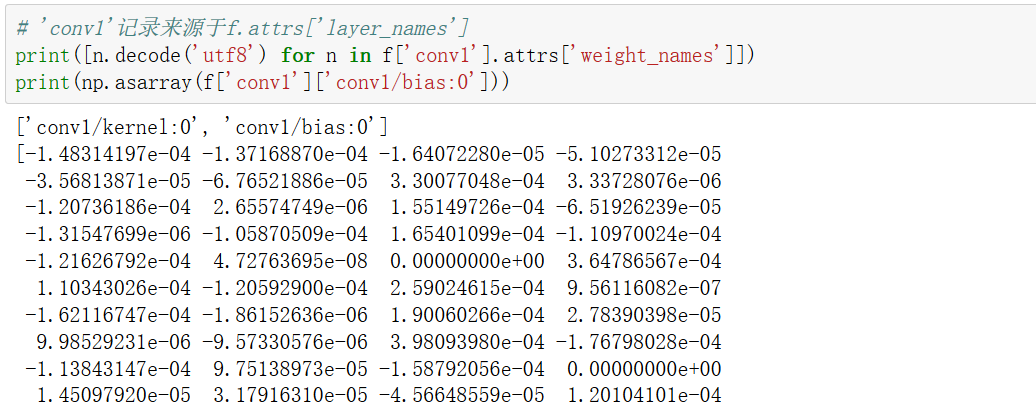
实际的载入参数时,keras API已经封装的很好了,不需要我们自己取对应h5中的名称和网络中的名称,然后更新参数值。交由saving.load_weights_from_hdf5_group_by_name(f, layers),输入f句柄,输入需要载入参数的层对象即可对应名字完成载入。
二、模型训练
本部不讲解网络结构,主要介绍的是训练步骤,网络结构介绍见:『计算机视觉』Mask-RCNN_训练网络其二:train网络结构
模型训练有两种模式,
Only the heads. Here we're freezing all the backbone layers and training only the randomly initialized layers (i.e. the ones that we didn't use pre-trained weights from MS COCO). To train only the head layers, pass
layers='heads'to thetrain()function.Fine-tune all layers. For this simple example it's not necessary, but we're including it to show the process. Simply pass
layers="allto train all layers.
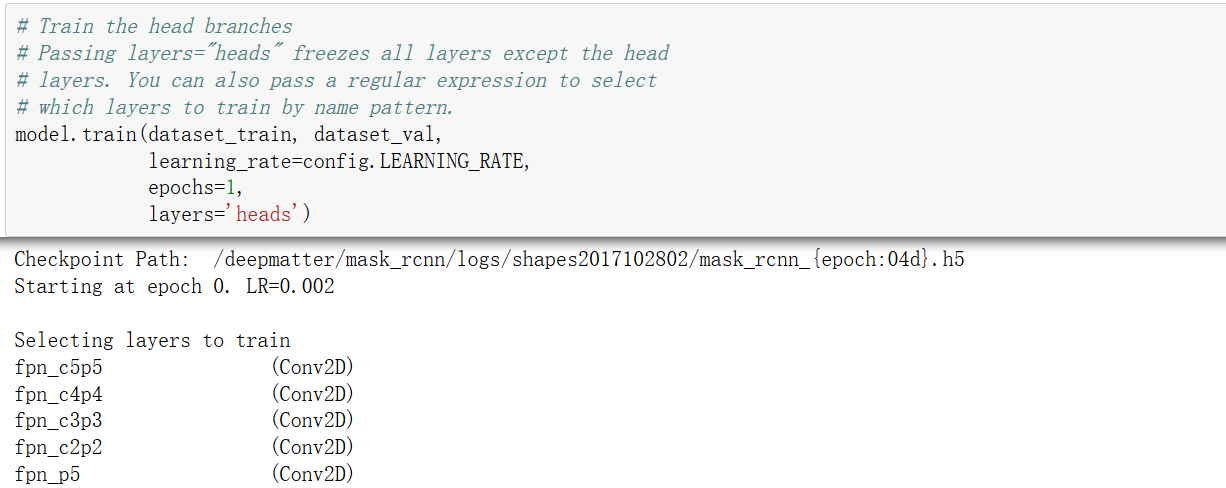
1、train方法文档
train方法声明如下
def train(self, train_dataset, val_dataset, learning_rate, epochs, layers,
augmentation=None, custom_callbacks=None, no_augmentation_sources=None)
文档说明如下
"""Train the model.
train_dataset, val_dataset: Training and validation Dataset objects.
learning_rate: The learning rate to train with
epochs: Number of training epochs. Note that previous training epochs
are considered to be done alreay, so this actually determines
the epochs to train in total rather than in this particaular
call.
layers: Allows selecting which layers to train. It can be:
- A regular expression to match layer names to train
- One of these predefined values:
heads: The RPN, classifier and mask heads of the network
all: All the layers
3+: Train Resnet stage 3 and up
4+: Train Resnet stage 4 and up
5+: Train Resnet stage 5 and up
augmentation: Optional. An imgaug (https://github.com/aleju/imgaug)
augmentation. For example, passing imgaug.augmenters.Fliplr(0.5)
flips images right/left 50% of the time. You can pass complex
augmentations as well. This augmentation applies 50% of the
time, and when it does it flips images right/left half the time
and adds a Gaussian blur with a random sigma in range 0 to 5. augmentation = imgaug.augmenters.Sometimes(0.5, [
imgaug.augmenters.Fliplr(0.5),
imgaug.augmenters.GaussianBlur(sigma=(0.0, 5.0))
])
custom_callbacks: Optional. Add custom callbacks to be called
with the keras fit_generator method. Must be list of type keras.callbacks.
no_augmentation_sources: Optional. List of sources to exclude for
augmentation. A source is string that identifies a dataset and is
defined in the Dataset class.
"""
2、模型准备&数据准备
首先对模型设置进行准备。
- 指定训练层时既可以输入层名层,也可以输入预定的字符串,输入预定字符串则其解析规则见下面开头几行。最终获取layers变量记录要训练层的名字(或者正则表达式)
- 然后准备数据,data_generator函数涉及预处理流程很繁琐(见model.py),可以自行查阅
- 生成文件保存目录
assert self.mode == "training", "Create model in training mode."
# Pre-defined layer regular expressions
layer_regex = {
# all layers but the backbone
"heads": r"(mrcnn\_.*)|(rpn\_.*)|(fpn\_.*)",
# From a specific Resnet stage and up
"3+": r"(res3.*)|(bn3.*)|(res4.*)|(bn4.*)|(res5.*)|(bn5.*)|(mrcnn\_.*)|(rpn\_.*)|(fpn\_.*)",
"4+": r"(res4.*)|(bn4.*)|(res5.*)|(bn5.*)|(mrcnn\_.*)|(rpn\_.*)|(fpn\_.*)",
"5+": r"(res5.*)|(bn5.*)|(mrcnn\_.*)|(rpn\_.*)|(fpn\_.*)",
# All layers
"all": ".*",
}
if layers in layer_regex.keys():
layers = layer_regex[layers]
# Data generators
train_generator = data_generator(train_dataset, self.config, shuffle=True,
augmentation=augmentation,
batch_size=self.config.BATCH_SIZE,
no_augmentation_sources=no_augmentation_sources)
val_generator = data_generator(val_dataset, self.config, shuffle=True,
batch_size=self.config.BATCH_SIZE)
# Create log_dir if it does not exist
if not os.path.exists(self.log_dir):
os.makedirs(self.log_dir)
3、model处理
这里主要的步骤就是
- 将前一步的可训练层名称传入函数self.set_trainable(layers),设置对应层对象的trainable属性为True
- self.compile方法设定优化器,综合各个loss给出整体优化对象,最后编译model
# Callbacks
callbacks = [
keras.callbacks.TensorBoard(log_dir=self.log_dir,
histogram_freq=0, write_graph=True, write_images=False),
keras.callbacks.ModelCheckpoint(self.checkpoint_path,
verbose=0, save_weights_only=True),
] # Add custom callbacks to the list
if custom_callbacks:
callbacks += custom_callbacks # Train
log("\nStarting at epoch {}. LR={}\n".format(self.epoch, learning_rate))
log("Checkpoint Path: {}".format(self.checkpoint_path))
self.set_trainable(layers)
self.compile(learning_rate, self.config.LEARNING_MOMENTUM) # Work-around for Windows: Keras fails on Windows when using
# multiprocessing workers. See discussion here:
# https://github.com/matterport/Mask_RCNN/issues/13#issuecomment-353124009
if os.name is 'nt':
workers = 0
else:
workers = multiprocessing.cpu_count() # 单机默认为0
self.compile方法
def compile(self, learning_rate, momentum):
"""Gets the model ready for training. Adds losses, regularization, and
metrics. Then calls the Keras compile() function.
"""
# Optimizer object
optimizer = keras.optimizers.SGD(
lr=learning_rate, momentum=momentum,
clipnorm=self.config.GRADIENT_CLIP_NORM)
# Add Losses
# First, clear previously set losses to avoid duplication
self.keras_model._losses = []
self.keras_model._per_input_losses = {}
loss_names = [
"rpn_class_loss", "rpn_bbox_loss",
"mrcnn_class_loss", "mrcnn_bbox_loss", "mrcnn_mask_loss"]
for name in loss_names:
layer = self.keras_model.get_layer(name)
if layer.output in self.keras_model.losses:
continue
loss = (
tf.reduce_mean(layer.output, keep_dims=True)
* self.config.LOSS_WEIGHTS.get(name, 1.))
self.keras_model.add_loss(loss) # Add L2 Regularization
# Skip gamma and beta weights of batch normalization layers.
reg_losses = [
keras.regularizers.l2(self.config.WEIGHT_DECAY)(w) / tf.cast(tf.size(w), tf.float32)
for w in self.keras_model.trainable_weights
if 'gamma' not in w.name and 'beta' not in w.name]
self.keras_model.add_loss(tf.add_n(reg_losses)) # Compile
self.keras_model.compile(
optimizer=optimizer,
loss=[None] * len(self.keras_model.outputs)) # Add metrics for losses
for name in loss_names:
if name in self.keras_model.metrics_names:
continue
layer = self.keras_model.get_layer(name)
self.keras_model.metrics_names.append(name)
loss = (
tf.reduce_mean(layer.output, keepdims=True)
* self.config.LOSS_WEIGHTS.get(name, 1.))
self.keras_model.metrics_tensors.append(loss)
self.set_trainable方法
def set_trainable(self, layer_regex, keras_model=None, indent=0, verbose=1):
"""Sets model layers as trainable if their names match
the given regular expression.
"""
# Print message on the first call (but not on recursive calls)
if verbose > 0 and keras_model is None:
log("Selecting layers to train") keras_model = keras_model or self.keras_model # In multi-GPU training, we wrap the model. Get layers
# of the inner model because they have the weights.
layers = keras_model.inner_model.layers if hasattr(keras_model, "inner_model")\
else keras_model.layers for layer in layers:
# Is the layer a model?
if layer.__class__.__name__ == 'Model': # 不同层隶属不同的class,但Model class是单一的
print("In model: ", layer.name)
self.set_trainable(
layer_regex, keras_model=layer, indent=indent + 4)
continue if not layer.weights:
continue
# Is it trainable?
trainable = bool(re.fullmatch(layer_regex, layer.name))
# Update layer. If layer is a container, update inner layer.
if layer.__class__.__name__ == 'TimeDistributed':
layer.layer.trainable = trainable
else:
layer.trainable = trainable
# Print trainable layer names
if trainable and verbose > 0:
log("{}{:20} ({})".format(" " * indent, layer.name,
layer.__class__.__name__))
4、训练model
最简单的一步了,调用keras接口训练即可,上一步定义的callbacks也是在这里传入
self.keras_model.fit_generator(
train_generator,
initial_epoch=self.epoch,
epochs=epochs,
steps_per_epoch=self.config.STEPS_PER_EPOCH,
callbacks=callbacks,
validation_data=val_generator,
validation_steps=self.config.VALIDATION_STEPS,
max_queue_size=100,
workers=workers,
use_multiprocessing=True,
)
self.epoch = max(self.epoch, epochs)
至此,train方法便自动的开始了模型的训练工作。
『计算机视觉』Mask-RCNN_训练网络其三:训练Model的更多相关文章
- 『计算机视觉』经典RCNN_其二:Faster-RCNN
项目源码 一.Faster-RCNN简介 『cs231n』Faster_RCNN 『计算机视觉』Faster-RCNN学习_其一:目标检测及RCNN谱系 一篇讲的非常明白的文章:一文读懂Faster ...
- 『计算机视觉』经典RCNN_其一:从RCNN到Faster-RCNN
RCNN介绍 目标检测-RCNN系列 一文读懂Faster RCNN 一.目标检测 1.两个任务 目标检测可以拆分成两个任务:识别和定位 图像识别(classification)输入:图片输出:物体的 ...
- 『计算机视觉』Mask-RCNN_推断网络其二:基于ReNet101的FPN共享网络暨TensorFlow和Keras交互简介
零.参考资料 有关FPN的介绍见『计算机视觉』FPN特征金字塔网络. 网络构架部分代码见Mask_RCNN/mrcnn/model.py中class MaskRCNN的build方法的"in ...
- 『计算机视觉』Mask-RCNN_推断网络其四:FPN和ROIAlign的耦合
一.模块概述 上节的最后,我们进行了如下操作获取了有限的proposal, # [IMAGES_PER_GPU, num_rois, (y1, x1, y2, x2)] # IMAGES_PER_GP ...
- 『计算机视觉』Mask-RCNN
一.Mask-RCNN流程 Mask R-CNN是一个实例分割(Instance segmentation)算法,通过增加不同的分支,可以完成目标分类.目标检测.语义分割.实例分割.人体姿势识别等多种 ...
- 『计算机视觉』Mask-RCNN_训练网络其二:train网络结构&损失函数
Github地址:Mask_RCNN 『计算机视觉』Mask-RCNN_论文学习 『计算机视觉』Mask-RCNN_项目文档翻译 『计算机视觉』Mask-RCNN_推断网络其一:总览 『计算机视觉』M ...
- 『计算机视觉』Mask-RCNN_训练网络其一:数据集与Dataset类
Github地址:Mask_RCNN 『计算机视觉』Mask-RCNN_论文学习 『计算机视觉』Mask-RCNN_项目文档翻译 『计算机视觉』Mask-RCNN_推断网络其一:总览 『计算机视觉』M ...
- 『计算机视觉』Mask-RCNN_推断网络其六:Mask生成
一.Mask生成概览 上一节的末尾,我们已经获取了待检测图片的分类回归信息,我们将回归信息(即待检测目标的边框信息)单独提取出来,结合金字塔特征mrcnn_feature_maps,进行Mask生成工 ...
- 『计算机视觉』Mask-RCNN_推断网络其三:RPN锚框处理和Proposal生成
一.RPN锚框信息生成 上文的最后,我们生成了用于计算锚框信息的特征(源代码在inference模式中不进行锚框生成,而是外部生成好feed进网络,training模式下在向前传播时直接生成锚框,不过 ...
随机推荐
- python笔记-正则表达式常用函数
1.re.findall()函数 语法:re.findall(pattern,string,flags=0) --> list(列表) 列出字符串中模式的所有匹配项,并作为一个列表返回.如果无匹 ...
- Chrome调试WebView时Inspect出现空白的解决方法(使用离线包不Fan墙)
起因 使用HTML5开发Android应用时,少不了调试WebView.做前端的还是习惯Chrome的开发者工具,以前都是输入Chrome://inspect就可以调试WebView了,太方便了. 最 ...
- navicat for mysql 数据库备份与还原
一, 首先设置, 备份保存路径 工具 -> 选项 点开 其他 -> 日志文件保存路径 二. 开始备份 备份分两种, 一种是以sql保存, 一种是保存为备份 SQL保存 右键点击你要备份的数 ...
- js对象属性名驼峰式转下划线
一.题目示例: 思路: 1.匹配属性名字符串中的大写字母和数字 2.通过匹配后的lastIndex属性获取匹配到的大写字母和数字的位置 3.判断大写字母的位置是否为首位置以及lastIndex是否为0 ...
- window中普通用户无法登录远程桌面
解决方案就是将该用户加到 Remote Desktop Users 这个用户组中. 使用命令 net localgroup "Remote Desktop Users" 用户名 / ...
- sitecore开发入门教程如何获取Sitecore项目的域名
我假设您在<sites>web.config文件的部分中设置了多个站点,并且每个站点都hostName定义了一个属性,例如 <site name="website1&quo ...
- STM32的型号的命名规则
每种STM32的产品都由16个字母或数字构成的编号标示,用户向ST订货时必须使用这个编号指定需要的产品.这16个字符分为8个部分,下面通过一个例子说明它们的意义: STM32 F C T xxx ST ...
- spring internalTransactionAdvisor 事务 advisor 初始化过程
spring internalTransactionAdvisor 事务 advisor 初始化过程:
- Redis学习-sorted set数据类型
sorted set 是有序集合,它在 set 的基础上增加了一个顺序属性,这一属性在添加修 改元素的时候可以指定,每次指定后,会自动重新按新的值调整顺序. zadd key score member ...
- SolrJ的入门
什么是SolrJ? solrj是访问solr服务的java客户端,提供索引和搜索的请求方法, SolrJ和图形界面操作的区别就类似于数据库中使用jdbc和mysql客户端的区别一样. 我在测试Solr ...
